Jiayuan Chen
Sherman
MedBench v4: A Robust and Scalable Benchmark for Evaluating Chinese Medical Language Models, Multimodal Models, and Intelligent Agents
Nov 19, 2025Abstract:Recent advances in medical large language models (LLMs), multimodal models, and agents demand evaluation frameworks that reflect real clinical workflows and safety constraints. We present MedBench v4, a nationwide, cloud-based benchmarking infrastructure comprising over 700,000 expert-curated tasks spanning 24 primary and 91 secondary specialties, with dedicated tracks for LLMs, multimodal models, and agents. Items undergo multi-stage refinement and multi-round review by clinicians from more than 500 institutions, and open-ended responses are scored by an LLM-as-a-judge calibrated to human ratings. We evaluate 15 frontier models. Base LLMs reach a mean overall score of 54.1/100 (best: Claude Sonnet 4.5, 62.5/100), but safety and ethics remain low (18.4/100). Multimodal models perform worse overall (mean 47.5/100; best: GPT-5, 54.9/100), with solid perception yet weaker cross-modal reasoning. Agents built on the same backbones substantially improve end-to-end performance (mean 79.8/100), with Claude Sonnet 4.5-based agents achieving up to 85.3/100 overall and 88.9/100 on safety tasks. MedBench v4 thus reveals persisting gaps in multimodal reasoning and safety for base models, while showing that governance-aware agentic orchestration can markedly enhance benchmarked clinical readiness without sacrificing capability. By aligning tasks with Chinese clinical guidelines and regulatory priorities, the platform offers a practical reference for hospitals, developers, and policymakers auditing medical AI.
TCM-5CEval: Extended Deep Evaluation Benchmark for LLM's Comprehensive Clinical Research Competence in Traditional Chinese Medicine
Nov 17, 2025Abstract:Large language models (LLMs) have demonstrated exceptional capabilities in general domains, yet their application in highly specialized and culturally-rich fields like Traditional Chinese Medicine (TCM) requires rigorous and nuanced evaluation. Building upon prior foundational work such as TCM-3CEval, which highlighted systemic knowledge gaps and the importance of cultural-contextual alignment, we introduce TCM-5CEval, a more granular and comprehensive benchmark. TCM-5CEval is designed to assess LLMs across five critical dimensions: (1) Core Knowledge (TCM-Exam), (2) Classical Literacy (TCM-LitQA), (3) Clinical Decision-making (TCM-MRCD), (4) Chinese Materia Medica (TCM-CMM), and (5) Clinical Non-pharmacological Therapy (TCM-ClinNPT). We conducted a thorough evaluation of fifteen prominent LLMs, revealing significant performance disparities and identifying top-performing models like deepseek\_r1 and gemini\_2\_5\_pro. Our findings show that while models exhibit proficiency in recalling foundational knowledge, they struggle with the interpretative complexities of classical texts. Critically, permutation-based consistency testing reveals widespread fragilities in model inference. All evaluated models, including the highest-scoring ones, displayed a substantial performance degradation when faced with varied question option ordering, indicating a pervasive sensitivity to positional bias and a lack of robust understanding. TCM-5CEval not only provides a more detailed diagnostic tool for LLM capabilities in TCM but aldso exposes fundamental weaknesses in their reasoning stability. To promote further research and standardized comparison, TCM-5CEval has been uploaded to the Medbench platform, joining its predecessor in the "In-depth Challenge for Comprehensive TCM Abilities" special track.
MedCalc-Eval and MedCalc-Env: Advancing Medical Calculation Capabilities of Large Language Models
Oct 31, 2025Abstract:As large language models (LLMs) enter the medical domain, most benchmarks evaluate them on question answering or descriptive reasoning, overlooking quantitative reasoning critical to clinical decision-making. Existing datasets like MedCalc-Bench cover few calculation tasks and fail to reflect real-world computational scenarios. We introduce MedCalc-Eval, the largest benchmark for assessing LLMs' medical calculation abilities, comprising 700+ tasks across two types: equation-based (e.g., Cockcroft-Gault, BMI, BSA) and rule-based scoring systems (e.g., Apgar, Glasgow Coma Scale). These tasks span diverse specialties including internal medicine, surgery, pediatrics, and cardiology, offering a broader and more challenging evaluation setting. To improve performance, we further develop MedCalc-Env, a reinforcement learning environment built on the InternBootcamp framework, enabling multi-step clinical reasoning and planning. Fine-tuning a Qwen2.5-32B model within this environment achieves state-of-the-art results on MedCalc-Eval, with notable gains in numerical sensitivity, formula selection, and reasoning robustness. Remaining challenges include unit conversion, multi-condition logic, and contextual understanding. Code and datasets are available at https://github.com/maokangkun/MedCalc-Eval.
Building a Human-Verified Clinical Reasoning Dataset via a Human LLM Hybrid Pipeline for Trustworthy Medical AI
May 11, 2025Abstract:Despite strong performance in medical question-answering, the clinical adoption of Large Language Models (LLMs) is critically hampered by their opaque 'black-box' reasoning, limiting clinician trust. This challenge is compounded by the predominant reliance of current medical LLMs on corpora from scientific literature or synthetic data, which often lack the granular expert validation and high clinical relevance essential for advancing their specialized medical capabilities. To address these critical gaps, we introduce a highly clinically relevant dataset with 31,247 medical question-answer pairs, each accompanied by expert-validated chain-of-thought (CoT) explanations. This resource, spanning multiple clinical domains, was curated via a scalable human-LLM hybrid pipeline: LLM-generated rationales were iteratively reviewed, scored, and refined by medical experts against a structured rubric, with substandard outputs revised through human effort or guided LLM regeneration until expert consensus. This publicly available dataset provides a vital source for the development of medical LLMs that capable of transparent and verifiable reasoning, thereby advancing safer and more interpretable AI in medicine.
TCM-3CEval: A Triaxial Benchmark for Assessing Responses from Large Language Models in Traditional Chinese Medicine
Mar 10, 2025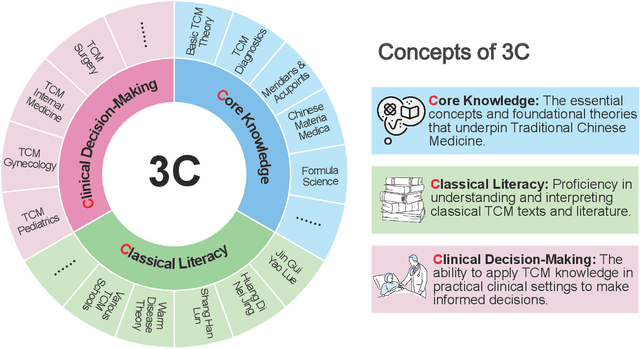
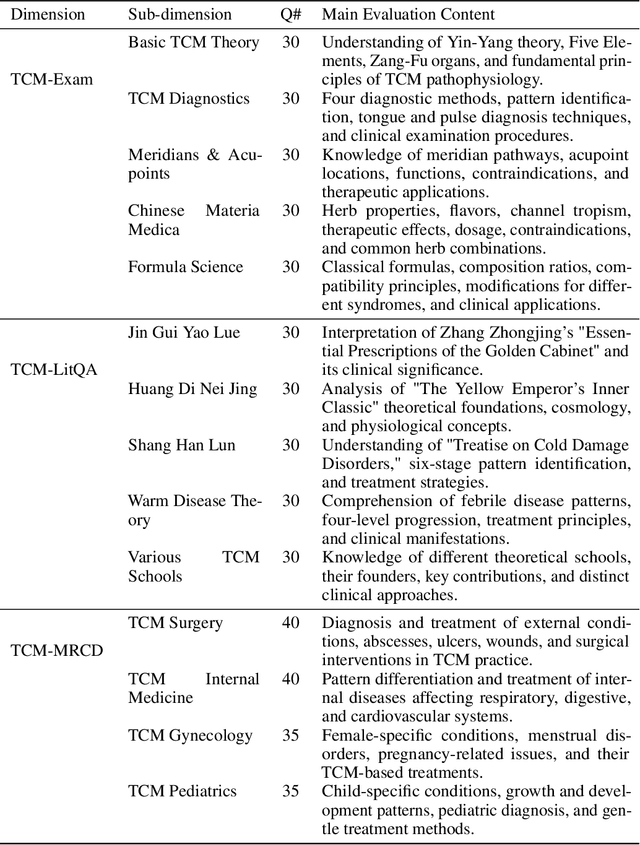
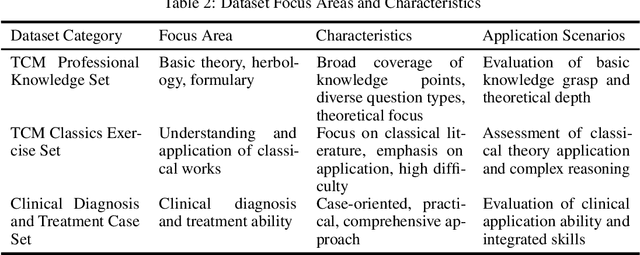

Abstract:Large language models (LLMs) excel in various NLP tasks and modern medicine, but their evaluation in traditional Chinese medicine (TCM) is underexplored. To address this, we introduce TCM3CEval, a benchmark assessing LLMs in TCM across three dimensions: core knowledge mastery, classical text understanding, and clinical decision-making. We evaluate diverse models, including international (e.g., GPT-4o), Chinese (e.g., InternLM), and medical-specific (e.g., PLUSE). Results show a performance hierarchy: all models have limitations in specialized subdomains like Meridian & Acupoint theory and Various TCM Schools, revealing gaps between current capabilities and clinical needs. Models with Chinese linguistic and cultural priors perform better in classical text interpretation and clinical reasoning. TCM-3CEval sets a standard for AI evaluation in TCM, offering insights for optimizing LLMs in culturally grounded medical domains. The benchmark is available on Medbench's TCM track, aiming to assess LLMs' TCM capabilities in basic knowledge, classic texts, and clinical decision-making through multidimensional questions and real cases.
Benchmarking Chinese Medical LLMs: A Medbench-based Analysis of Performance Gaps and Hierarchical Optimization Strategies
Mar 10, 2025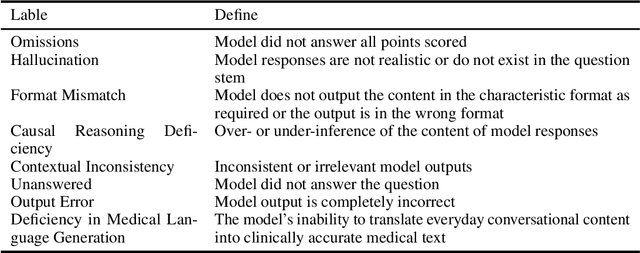
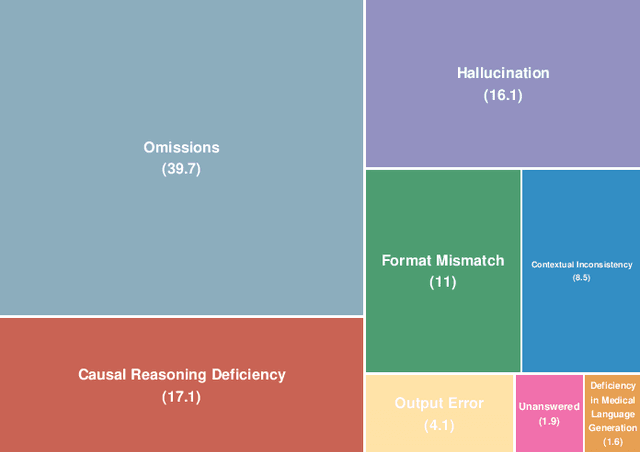

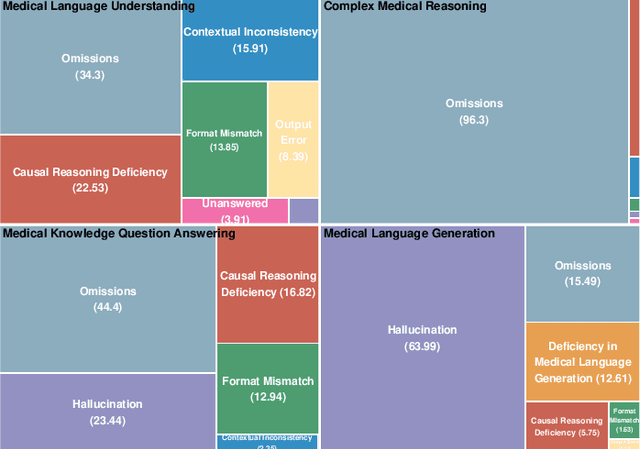
Abstract:The evaluation and improvement of medical large language models (LLMs) are critical for their real-world deployment, particularly in ensuring accuracy, safety, and ethical alignment. Existing frameworks inadequately dissect domain-specific error patterns or address cross-modal challenges. This study introduces a granular error taxonomy through systematic analysis of top 10 models on MedBench, categorizing incorrect responses into eight types: Omissions, Hallucination, Format Mismatch, Causal Reasoning Deficiency, Contextual Inconsistency, Unanswered, Output Error, and Deficiency in Medical Language Generation. Evaluation of 10 leading models reveals vulnerabilities: despite achieving 0.86 accuracy in medical knowledge recall, critical reasoning tasks show 96.3% omission, while safety ethics evaluations expose alarming inconsistency (robustness score: 0.79) under option shuffled. Our analysis uncovers systemic weaknesses in knowledge boundary enforcement and multi-step reasoning. To address these, we propose a tiered optimization strategy spanning four levels, from prompt engineering and knowledge-augmented retrieval to hybrid neuro-symbolic architectures and causal reasoning frameworks. This work establishes an actionable roadmap for developing clinically robust LLMs while redefining evaluation paradigms through error-driven insights, ultimately advancing the safety and trustworthiness of AI in high-stakes medical environments.
Predictive Modeling with Temporal Graphical Representation on Electronic Health Records
May 07, 2024



Abstract:Deep learning-based predictive models, leveraging Electronic Health Records (EHR), are receiving increasing attention in healthcare. An effective representation of a patient's EHR should hierarchically encompass both the temporal relationships between historical visits and medical events, and the inherent structural information within these elements. Existing patient representation methods can be roughly categorized into sequential representation and graphical representation. The sequential representation methods focus only on the temporal relationships among longitudinal visits. On the other hand, the graphical representation approaches, while adept at extracting the graph-structured relationships between various medical events, fall short in effectively integrate temporal information. To capture both types of information, we model a patient's EHR as a novel temporal heterogeneous graph. This graph includes historical visits nodes and medical events nodes. It propagates structured information from medical event nodes to visit nodes and utilizes time-aware visit nodes to capture changes in the patient's health status. Furthermore, we introduce a novel temporal graph transformer (TRANS) that integrates temporal edge features, global positional encoding, and local structural encoding into heterogeneous graph convolution, capturing both temporal and structural information. We validate the effectiveness of TRANS through extensive experiments on three real-world datasets. The results show that our proposed approach achieves state-of-the-art performance.
Energy-Efficient UAV Swarm Assisted MEC with Dynamic Clustering and Scheduling
Feb 29, 2024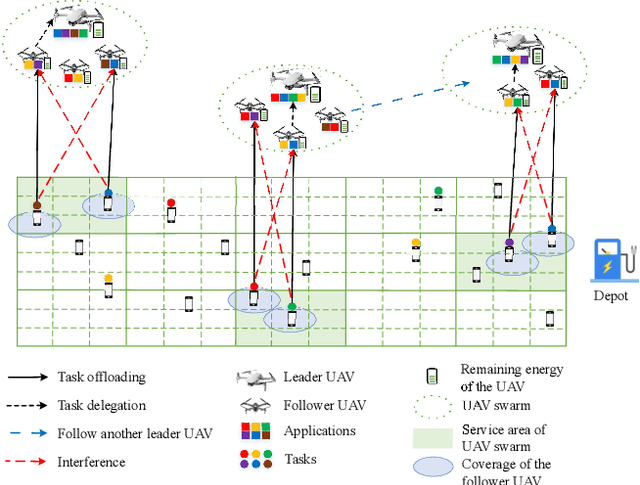

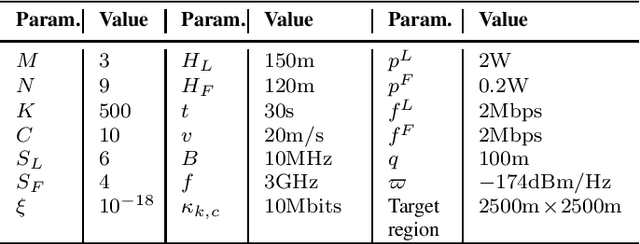
Abstract:In this paper, the energy-efficient unmanned aerial vehicle (UAV) swarm assisted mobile edge computing (MEC) with dynamic clustering and scheduling is studied. In the considered system model, UAVs are divided into multiple swarms, with each swarm consisting of a leader UAV and several follower UAVs to provide computing services to end-users. Unlike existing work, we allow UAVs to dynamically cluster into different swarms, i.e., each follower UAV can change its leader based on the time-varying spatial positions, updated application placement, etc. in a dynamic manner. Meanwhile, UAVs are required to dynamically schedule their energy replenishment, application placement, trajectory planning and task delegation. With the aim of maximizing the long-term energy efficiency of the UAV swarm assisted MEC system, a joint optimization problem of dynamic clustering and scheduling is formulated. Taking into account the underlying cooperation and competition among intelligent UAVs, we further reformulate this optimization problem as a combination of a series of strongly coupled multi-agent stochastic games, and then propose a novel reinforcement learning-based UAV swarm dynamic coordination (RLDC) algorithm for obtaining the equilibrium. Simulations are conducted to evaluate the performance of the RLDC algorithm and demonstrate its superiority over counterparts.
Edge Computing Enabled Real-Time Video Analysis via Adaptive Spatial-Temporal Semantic Filtering
Feb 29, 2024



Abstract:This paper proposes a novel edge computing enabled real-time video analysis system for intelligent visual devices. The proposed system consists of a tracking-assisted object detection module (TAODM) and a region of interesting module (ROIM). TAODM adaptively determines the offloading decision to process each video frame locally with a tracking algorithm or to offload it to the edge server inferred by an object detection model. ROIM determines each offloading frame's resolution and detection model configuration to ensure that the analysis results can return in time. TAODM and ROIM interact jointly to filter the repetitive spatial-temporal semantic information to maximize the processing rate while ensuring high video analysis accuracy. Unlike most existing works, this paper investigates the real-time video analysis systems where the intelligent visual device connects to the edge server through a wireless network with fluctuating network conditions. We decompose the real-time video analysis problem into the offloading decision and configurations selection sub-problems. To solve these two sub-problems, we introduce a double deep Q network (DDQN) based offloading approach and a contextual multi-armed bandit (CMAB) based adaptive configurations selection approach, respectively. A DDQN-CMAB reinforcement learning (DCRL) training framework is further developed to integrate these two approaches to improve the overall video analyzing performance. Extensive simulations are conducted to evaluate the performance of the proposed solution, and demonstrate its superiority over counterparts.
Generative AI-Driven Human Digital Twin in IoT-Healthcare: A Comprehensive Survey
Jan 22, 2024Abstract:The Internet of things (IoT) can significantly enhance the quality of human life, specifically in healthcare, attracting extensive attentions to IoT-healthcare services. Meanwhile, the human digital twin (HDT) is proposed as an innovative paradigm that can comprehensively characterize the replication of the individual human body in the digital world and reflect its physical status in real time. Naturally, HDT is envisioned to empower IoT-healthcare beyond the application of healthcare monitoring by acting as a versatile and vivid human digital testbed, simulating the outcomes and guiding the practical treatments. However, successfully establishing HDT requires high-fidelity virtual modeling and strong information interactions but possibly with scarce, biased and noisy data. Fortunately, a recent popular technology called generative artificial intelligence (GAI) may be a promising solution because it can leverage advanced AI algorithms to automatically create, manipulate, and modify valuable while diverse data. This survey particularly focuses on the implementation of GAI-driven HDT in IoT-healthcare. We start by introducing the background of IoT-healthcare and the potential of GAI-driven HDT. Then, we delve into the fundamental techniques and present the overall framework of GAI-driven HDT. After that, we explore the realization of GAI-driven HDT in detail, including GAI-enabled data acquisition, communication, data management, digital modeling, and data analysis. Besides, we discuss typical IoT-healthcare applications that can be revolutionized by GAI-driven HDT, namely personalized health monitoring and diagnosis, personalized prescription, and personalized rehabilitation. Finally, we conclude this survey by highlighting some future research directions.
 Add to Chrome
Add to Chrome Add to Firefox
Add to Firefox Add to Edge
Add to Edge